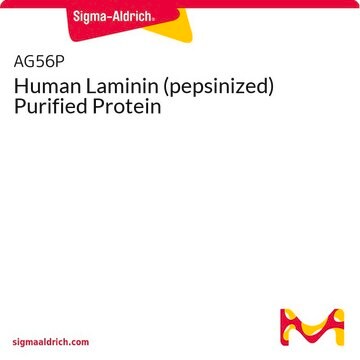SCR127
Synthetic Laminin
Synthetic peptide, powder, suitable for the in vitro culture of rat neural stem cells
Sign Into View Organizational & Contract Pricing
All Photos(1)
About This Item
UNSPSC Code:
12352202
eCl@ss:
32160405
NACRES:
NA.75
Recommended Products
product name
Synthetic Laminin Peptide for Rat Neural Stem Cells,
Assay
>95% (HPLC)
Quality Level
form
lyophilized
technique(s)
cell culture | mammalian: suitable
input
sample type neural stem cell(s)
UniProt accession no.
shipped in
dry ice
storage temp.
−20°C
Gene Information
rat ... Lamb2(25473)
General description
Laminin, an extracellular matrix protein of the cell basement membrane, is involved in various biological activities including cell adhesion, proliferation, migration, invasion, and differentiation These heterotrimeric macromolecules - consisting of α, β, and γ chains - are difficult to extract and purify in consistently active quantities from native tissues. While some of these laminin isoforms can be isolated from either cultured cells or placental tissues, in both cases, overall protein yields tend to be relatively low and suffer from batch to batch variations. Therefore, for many stem cell scientists, it has become necessary to test each new lot laminin to ensure that the activity level of the protein was sufficient to sustain their stem cell culture.
To overcome this time barrier, a defined synthetic laminin substrate with similar binding and functional properties of the native laminin protein is considered to be highly advantageous as it would eliminate the requirement to test and screen new lots of native protein. Millipore’s Synthetic Laminin Peptide is a suitable replacement for the native laminin protein, and has been optimized to specifically support cell adhesion, proliferation and multi-lineage differentiation of rat neural stem cells (NSCs) in vitro. Rat neural stem cells grown on tissue culture plates coated with the synthetic laminin peptides display the characteristic neural stem cell markers, Nestin and Sox-2, and furthermore possess the capacity to preferentially differentiate down both glial and neural lineages. Millipore’s Synthetic Laminin Peptide is an inexpensive, reproducible, and defined ECM substrate alternative for the in vitro culture of rat neural stem cells.
(Note: This product has been optimized to support the growth of rat NSCs, and is not recommended for use with human or mouse NSCs).
To overcome this time barrier, a defined synthetic laminin substrate with similar binding and functional properties of the native laminin protein is considered to be highly advantageous as it would eliminate the requirement to test and screen new lots of native protein. Millipore’s Synthetic Laminin Peptide is a suitable replacement for the native laminin protein, and has been optimized to specifically support cell adhesion, proliferation and multi-lineage differentiation of rat neural stem cells (NSCs) in vitro. Rat neural stem cells grown on tissue culture plates coated with the synthetic laminin peptides display the characteristic neural stem cell markers, Nestin and Sox-2, and furthermore possess the capacity to preferentially differentiate down both glial and neural lineages. Millipore’s Synthetic Laminin Peptide is an inexpensive, reproducible, and defined ECM substrate alternative for the in vitro culture of rat neural stem cells.
(Note: This product has been optimized to support the growth of rat NSCs, and is not recommended for use with human or mouse NSCs).
Packaging
5 x 3 mg
Physical form
Lyophilized peptide
Storage and Stability
The Synthetic Laminin Peptide (Catalog No. SCR127) is shipped lyophilized and should be stored at -20°C upon receipt. Once the peptide has been reconstituted, it should be stored at 4ºC and used within 1 month.
Legal Information
Accutase is a registered trademark of Innovative Cell Technologies, Inc.
Disclaimer
Unless otherwise stated in our catalog or other company documentation accompanying the product(s), our products are intended for research use only and are not to be used for any other purpose, which includes but is not limited to, unauthorized commercial uses, in vitro diagnostic uses, ex vivo or in vivo therapeutic uses or any type of consumption or application to humans or animals.
Storage Class Code
11 - Combustible Solids
WGK
WGK 3
Flash Point(F)
Not applicable
Flash Point(C)
Not applicable
Certificates of Analysis (COA)
Search for Certificates of Analysis (COA) by entering the products Lot/Batch Number. Lot and Batch Numbers can be found on a product’s label following the words ‘Lot’ or ‘Batch’.
Already Own This Product?
Find documentation for the products that you have recently purchased in the Document Library.
Daniele Bottai et al.
Human molecular genetics, 28(1), 64-73 (2018-09-22)
Cornelia de Lange syndrome (CdLS), which is reported to affect ∼1 in 10 000 to 30 000 newborns, is a multisystem organ developmental disorder with relatively mild to severe effects. Among others, intellectual disability represents an important feature of this condition. CdLS
Alex Straiker et al.
Molecules (Basel, Switzerland), 26(17) (2021-09-11)
Cannabis contains more than 100 phytocannabinoids. Most of these remain poorly characterized, particularly in neurons. We tested a panel of five phytocannabinoids-cannabichromene (CBC), cannabidiolic acid (CBDA), cannabidivarin (CBDV), cannabidivarinic acid (CBDVA), and Δ9-tetrahydrocannabivarin (THCV) in two neuronal models, autaptic hippocampal
James H Felce et al.
Science signaling, 11(561) (2018-12-20)
For many years, the high-affinity receptor for immunoglobulin E (IgE) FcεRI, which is expressed by mast cells and basophils, has been widely held to be the exemplar of cross-linking (that is, aggregation dependent) signaling receptors. We found, however, that FcεRI
Our team of scientists has experience in all areas of research including Life Science, Material Science, Chemical Synthesis, Chromatography, Analytical and many others.
Contact Technical Service







